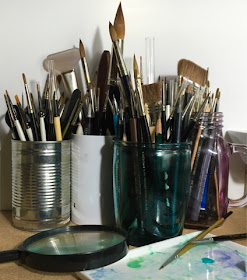 |
| Paintbrushes accumulated over the years! p.s. only store this way when dry, otherwish water and paint lies in the ferrule and that's bad! |
What is a miniature or spotter? Both miniature and spotter brushes are short haired brushes that allow excellent control for fine detail work, this feature makes them very useful to botanical artists who favour dry brush and fine detail techniques, and is especially good for the vellum painter. A spotter is much the same as a miniature but sometimes has a slightly fatter belly, both should have a sharp tapered point for extra fine detail.
What size of spotter is best? I don't often use anything anything smaller than a size 1 and in these brushes certainly no larger than a size 3, although sizes seem to vary between manufacturers.
For washes I use round or pointed brushes which have longer hairs and size 5 or 6 plus, I also use flats for some jobs such as lifting and half riggers for long flowing lines. I'll discuss them some other time in a separate post.
| The five brushes left to right: Winsor & Newton Series 7 miniature, Rosemary & Co spotter, David Jackson spotter, Raphael 8048 and Pro Arte series 107 |
The 5 Brushes
Winsor and Newton Series 7 miniatures, Kolinsky sable size 1 £8.25 - £12
One of the most popular brushes and one that I've used for many years, but have noticed some inconsistency in quality over the past few years with stray and bent hairs. It's a lovely looking brush though and handles well. It appears to be made with hairs slightly longer hairs in the middle compared to the outside, I think maybe for this reason they splay slightly sometimes. But it's generally a really good 'all rounder' and has a lovely point, which is superior to the Rosemary and Co but not as good as the David Jackson or the Raphael although probably on a par with the Pro Arte. The lines that I painted with it were fine but not as clean as others. It's good for dry brush work but it's an expensive brush to wears out if you use it for this purpose. I feel like the hairs are finer and softer than say the Raphael but not as soft as the Rosemary &Co, great for very delicate work, where little pressure is required, such as on vellum.
 |
| The effect on W & N and Rosemary and Co after much dry brush work! |
Rosemary & Co spotter series 325, size 1 £4.25
Half the price of most sable brushes, to me this spotter is really a different type of brush. Looking at the 5 brushes together, you can immediately see that it's much fatter in the belly than the other miniatures and has more hairs which seem softer and possibly finer - I should really put this to the test under the microscope but this is just a quick post! The point seems to dull quite quickly, possibly because of the finer hair, but initially it's a good enough point and if you don't paint so much it should last a while. The biggest problem I have with Rosemary & Co brushes is the splaying of hairs, worse than W & N and which happens fairly early on in the life of the brush, and even more so with the longer haired round / pointed brushes. The point is less tapered too and this tends to result in less of a smooth fine line compared to the David Jackson and the Raphael brushes, on close analysis the fine lines are more broken up and therefore less contact is made with the paper so perhaps this is to do whith the chunky build and maybe a bit more water is needed. Having said all that, this brush comes into its own for 'modelling' dry brush work and I use it largely for this purpose. It lasts for ages and is actually better with some wear. In particular, I love it for what I call 'polishing' dry brush work on vellum, which is an approach that I use to add a very fine layer of colour over previous dry brush to give shine, it's a very dry approach using quite a bit of pressure which allows me to layer, similar to the equivalent of a final wash on a watercolour. Below is an example of using a Rosemary and Co spotter on a maple leaf to get the 'polished, look on vellum!
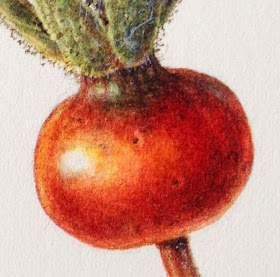 |
| Rosemary and Co spotters are great for dry brush work to achieve rich colour and depth |
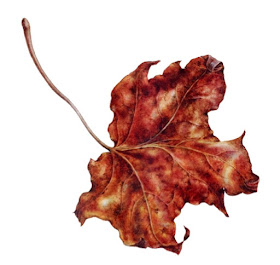 |
| Also 'Polishing' dry brush is easier to achieve with the Rosemary & Co spotter |
David Jackson Spotter, size 1 £? Contact The Brushman for information
David Jackson is a true craftsman and he made some spotter brushes for me several years ago, I think back 2012. I use them frequently and they are as good today as they were the day he very kindly put them through my door! The fine line work is by far the best, the brush holds enough water in its belly to maintain contact with the paper for a flowing fine line. This is my favourite little brush for detail working on vellum, I love to use it when painting butterflies, the fine point can give incredible detail for the most delicate dry brush work yet doesn't seem to wear at all, probably because so little pressure is required and it just glides across the surface with no friction. The hairs are quite soft though so it won't allow an lifting but that not the purpose of a brush like this.
 |
| David Jackson's brushes are perfect for fine lines and detail, such as the fine scales of a moth wing |
Raphael 8404 Red Sable size 3/0 approx £7 -£10
Narrower at the ferrule than series 7 and considerably narrower than the Rosemary & Co. This brush is more tapered but has enough belly to hold the right amount of water. This allows beautiful fine lines to be painted. It also seems a bit stiffer and is great for tidying edges and line work. I find the firmer brush perfect for fine tapered hairs when using body colour but also for very fine details, such as veins as well as for tidying edges. An excellent and versatile brush that rivals the Winsor & Newton miniature. Here's a link for the lowest price 8404. They also make the 8400 which is Kolinsky sable and extra short round brush, which is probably even better for dry brush.....I've ordered one! Beautiful brushes that last. I've had mine in excess of 5 years.
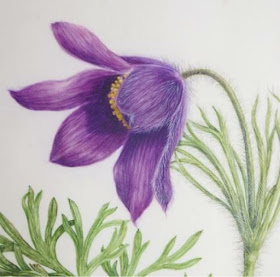 |
| Using the Raphael for painting fine hairs with body colour and a grey fine shadow line too. This gives additional depth to the hairs |
Pro Arte 107 spotter, size 1 £2.60 - £3.50
A great low cost synthetic brush for lovely fine detail. I've only recently started using this one but on the downside the point goes fairly soon and you get that characteristic bent tip thet happens with many synthetic brushes but for the price, and if you don't like to use animal poducts, it's a pretty amazing little brush. Below is one I purchased a couple of weeks ago, and you can see the point has bent but if you use it for fine line work and not for dry brush it will last long. The fine lines are actually marginally better than with the W& N brush and the stiffer synthetic hair means you can tidy up edges and push the paint a little more than with a sable brush als good for hairs. So again it's a brush with a slightly different role and one I use a lot! Sold by several shops, including Heaton Cooper and Pullingers but often in the craft / hobby range
 |
| The point start to bend and this happens a lot with synthetics but it's still a fantastic little brush |
Sets of Brushes
I don't bother with sets of brushes by one manufactuer, because you usually end up with one or two that you don't need and often there are good offers on some brushes, so it's a bit of a false economy. But it you have no idea regarding where to start I supose it gives a taster of whats available.
Which is the Best?
I don't bother with sets of brushes by one manufactuer, because you usually end up with one or two that you don't need and often there are good offers on some brushes, so it's a bit of a false economy. But it you have no idea regarding where to start I supose it gives a taster of whats available.
Which is the Best?
To be fair I like and use all of these brushes, I'd say the one that impresses me the most is David Jackson's brush, because of the smoothness of the line and the lack of friction between paper and brush. But I like them all for different reasons as outlined above. I tested them all out for lines the various dry brush techniques and they all have slightly different outcomes. I actually think it's worth investing in one of each of these brushes as a learner. They will all be used and small brushes are not so expensive. You can shop around and buy all of them for under £35! You may well find you have different preference but the best way to find out what suits you is to try different types, rather than blindly following somebody else's suggestions. Your brush really can make a difference and its very personal!
There's much more I could say about brushes and will try to write another post on other brushes at some time. This just filled the darkest of mornings when painting was near on impossible! hence the dark photographs.
 |
| Painting lines, David Jackson and Raphael were clear winners here. |
 |
| Closer ( magnified x2) inspection shows the smoother lines from the Jackson brush but the Rosemary and Co is better suited to dry brush |



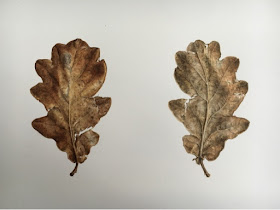
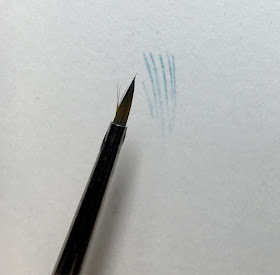

The Raphael 8404 & 8408 are also Kolinsky.
ReplyDeleteYes they are, I forgot to include that. Thank you
ReplyDeleteHi Dianne,
ReplyDeleteI love the post and the Blog is fab'.
I have been wondering about the brushes needed for botanical work and looking closely at the ones used by other artists, as the watercolour is getting close on the course.
Anna Mason uses a set of 5 Rosemary + Co Kolinsky spotters, and I have some of those. I also have some Escodas Tajmyr sables which are really good, although a lot of my brushes are larger due to my usual landscape painting.
I asked Shevaun about it and she loves the series 7 as you know, so I am going to take your advice and grab one of each! The Brushman is on Google search but I can't find any way to contact him.
Take care Dianne,
David.
thank you, it is wonderful to read about the brushes you use and as to the how and why.
ReplyDeleteVery helpful post, Dianne, thank you! :)
ReplyDeleteThis comment has been removed by the author.
ReplyDelete